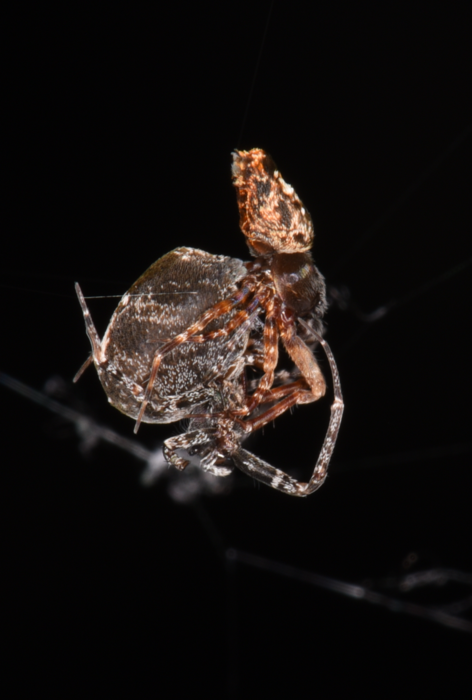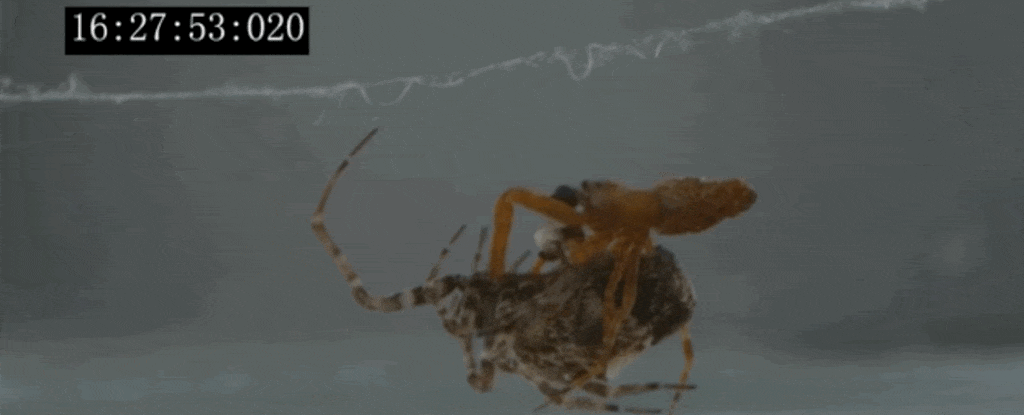The male communal orb-weaving spider Philoponella prominens is a regular relationship ghoster.
After a bit of hanky panky with a female, male spiders will abruptly beat a retreat, hurling themselves away from their partner faster than most cameras can record. In the end, though, they usually come crawling back for more.
What sounds like a cruel on-again, off-again romance is actually the male's way of saving its neck… quite literally.
If the male P. prominens doesn't split immediately after fornicating with a female, he risks becoming a post-sex snack.
When researchers studied 155 successful spider matings in the lab, they found only three males failed to catapult themselves away in the aftermath.
All of these unfortunate creatures met the same cut-throat fate. They were captured, killed, and consumed by the female.
When researchers intervened in the spider matings and physically stopped an additional 30 male spiders from jumping away after copulation, they, too, fell prey to their partners.
"These results clearly indicate that the catapulting behavior is an obligatory component of the male mating repertoire and a strategy to avoid the females' attempts at post-mating sexual cannibalism," the authors write.
 Orb-weaving spiders copulating, with the smaller male spider on top. (Shichang Zhang)
Orb-weaving spiders copulating, with the smaller male spider on top. (Shichang Zhang)
Filming the spiders with high-resolution, high-speed cameras, researchers have figured out how males of this species escape the clutches of their sex partners.
After cautiously approaching and copulating with a female, the male orb-weaving spiders appear to use their front legs to kick off the female, throwing themselves through the air at up to 88 centimeters per second (cm/s).
For each second of their flight, researchers found the spider will spin around roughly 175 times.
This impressive acrobatic escape is achieved by the male's first pair of forelegs, which bend against the female before rapidly opening up to push the spider off.
Researchers say the hydraulic pressure from fluid build-up in the forelimbs is what ultimately allows the male to jump away with such incredible speed.
This is a slightly different mechanism to what is seen in other jumping spiders, which tend to extend their fourth pair of legs to soar through the air. The joint among orb-weaving spiders, however, lacks extensor muscles in its forelimbs.
In the wild, a male orb-weaving spider will sometimes mate six times with the same female, climbing up to the partner, copulating, and then bouncing off her body to escape her clutches. Sometimes, he will even lose a few legs in the process.
To keep coming back, the male keeps a safety line continuously tied to the female's web. Just in case he wants to brave another round.
When researchers cut this safety line in the lab, male spiders dropped out of the air mid-catapult and were unable to climb back up to the female.
Researchers suspect the abseiling technique evolved as a strategy for male spiders to outwit the ornery opposite sex into taking their sperm.
"Females may use this behavior to judge the quality of a male during mating," explains animal behaviorist Shichang Zhang of Hubei University in Wuhan, China.
"If a male could not perform catapulting, then kill it, and if a male could perform it multiple times, then accept its sperm."
And we thought the human dating scene was brutal.
The study was published in Current Biology.
